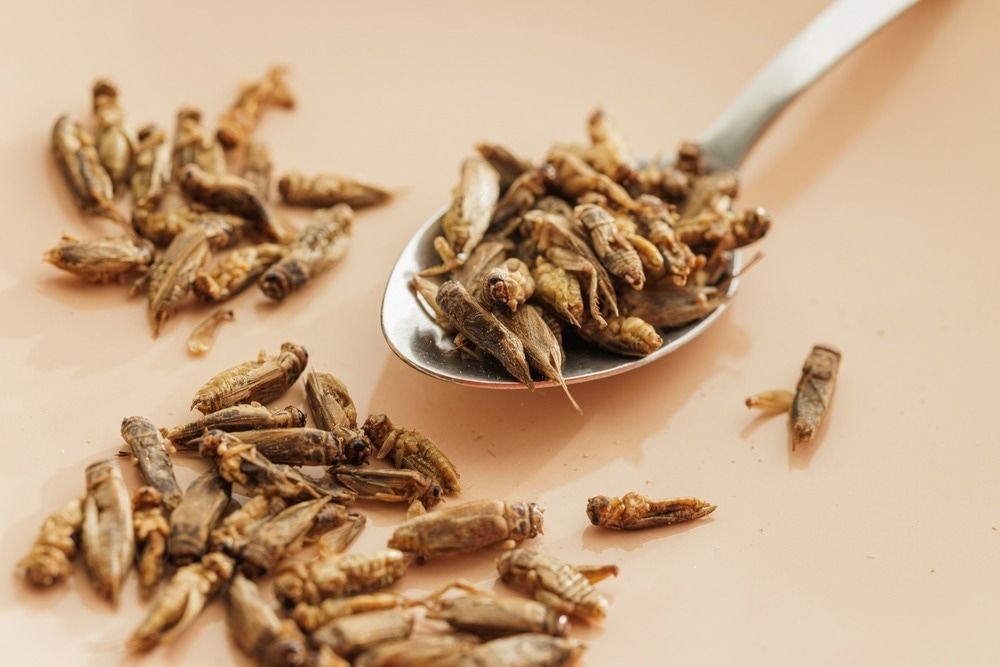A systematic review of human studies published in Nutrients reveals that insect proteins are as good as other protein sources in providing essential amino acids and other health benefits.
Background
Edible insects are considered highly nutritious food in many countries, including Africa, Asia, Australia, Oceania, and Latin America. Humans consume more than 2,000 insect species; of them, beetles, caterpillars, bees, wasps, ants, grasshoppers, locusts, crickets, true bugs, dragonflies, termites, flies, and cockroaches are the most commonly consumed insects worldwide.
Insects require less feed, water, and land use for survival. They also emit lower amounts of greenhouse gases than conventional animal protein sources. Because of these factors, insects are considered a sustainable and nutritious food source. In some countries, insects are considered a nutraceutical food source because of their medicinal properties, including antioxidant, anti-inflammatory, immunomodulatory, anti-microbial, and gastrointestinal protection.
In this systematic review, scientists analyzed the results of randomized controlled trials and allergenicity assessment studies investigating insect consumption’s health impact on human adults.
Scientists searched various scientific databases to identify in vivo human studies published between 2012 and 2022. From an initial screening of 1063 studies, they selected nine randomized controlled trials and five allergenicity assessment studies.
Randomized controlled trials
The primary outcomes of selected trials were iron absorption, amino acid absorption and muscle protein synthesis, amino acid synthesis and appetite regulation, microbiota, and disease treatment. Insect-based products tested in these trials included protein or flour derived from crickets, lesser mealworms, and silkworms.
Iron absorption
The analysis of trial findings revealed differences in iron absorption between high-phytate and low-phytate meals. Phytate acts as the main inhibitor of iron absorption.
In trials where low-phytate meals were consumed, significantly lower iron absorption was noticed for insect-based test meals compared to placebo meals. In contrast, no significant difference in iron absorption was observed between insect-based and placebo meals for high-phytate meals. Notably, comparable plasma hemoglobin and ferritin levels were observed for insect and placebo meals, irrespective of the meal phytate content.
Amino acid absorption and muscle protein synthesis
Post-prandial amino acid level was assessed after insect protein-based or conventional animal protein-based products were consumed. An induction in amino acid level was observed, irrespective of protein sources.
The comparison of insect protein sources with other protein sources revealed no significant differences in post-prandial essential amino acid levels. However, ingestion of insect proteins appeared to be associated with lower and delayed peaks of amino acids, including leucine, branched-chain amino acids, essential amino acids, non-essential amino acids, and total amino acids.
Metabolic disease biomarkers
A comparable blood glucose level was observed after ingestion of insect proteins and other animal proteins. In contrast, a lower insulin level was observed after insect protein consumption than after consuming soy, whey, and beef protein.
Regarding pro-inflammatory mediators, a significantly lower level of tumor necrosis factor was observed after insect-based meal consumption compared to placebo meal consumption.
Appetite regulation
Overall, insect-based food products had no significant impact on appetite regulation. A sensation of indigestion after insect meal consumption was reported in one study. Another study reported lower hunger sensation after consuming high quantities of cricket and lesser worm.
Microbiota
Only one study reported decreased levels of Lactobacillus spp. and increased levels of Bifidobacterium after consumption of insect-based meal. A reduction in acetate and propionate short-chain fatty acid synthesis by gut microbiota after ingestion of insect meal was also reported in this study.
Disease treatment
One study assessed the therapeutic efficacy of Caoshi silkworm granules supplemented for three months with routine medication in chronic obstructive pulmonary disease (COPD) patients.
The findings revealed no significant difference in pulmonary functions between granule-supplemented and placebo-supplemented patients. However, improvements in respiratory symptoms and activity were observed following granule supplementation.
Allergenicity assessment studies
A case study of a 31-year-old man allergic to house dust mites revealed severe food anaphylaxis after ingestion of mealworm. Tenebrio Molitor proteins were identified as the main allergy-inducing agents structurally similar to house dust mite proteins.
Epidemiological findings indicated that allergens from mopane worms, a popular indigenous edible insect, can induce respiratory symptoms in a vulnerable rural community occupationally involved in mopane worm harvesting. About 50% of participants from this community were found to be sensitive to this worm.
Cross-reactivity studies revealed that cricket allergens can cross-react with shrimp allergens. A high molecular weight tropomyosin was identified as the major cross-reactive allergen between both species. Similar cross-reactivity was detected between yellow mealworm allergens, shrimp, and house dust mite allergens.
Different thermal treatments, including boiling and frying, partially reduced the cross-reactivity between shrimp, house dust mites, and insect allergens.
Study significance
This systematic review of existing literature indicates that insect proteins are a valuable nutritional source with many health benefits. Future studies are needed to fully understand the safety and benefits of edible insects so that they can be introduced into regular human diets.
Credit: Source link




